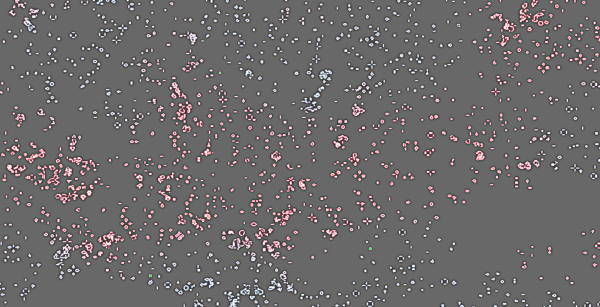BY LETTER
Conway's World
Megastructure of unknown terragen origin that displays a simple cellular automation cycle. | |
 Image from Steve Bowers | |
| The tiles of Conway's world appear dull grey from a distance, although slowly fluctuating patches of variant hue are visible | |
In the late Central Alliance era, a routine stellar survey program detected an unusual planet-like object which had not been detected before. This object was located in the JD 882910-1 system, in the Auriga outer volumes 3709 ly from Sol, beyond the explored region of the Terragen Sphere at that date. A number of anomalies were immediately apparent: the object had a toroidal profile, and its density was far lower than that of any known terrestrial world. Although at the time no plans to explore the system had been made, it was flagged "interesting" by the project's overseeing transapient and left for future expeditions to follow up on.
In 8563 AT, an explorer-class ship first entered the system. It discovered that the object was an artificial toroidal structure, nearly 16,200 kilometers in diameter and massing about 14% as much as the Earth. Composed primarily of diamondoid, the object is orbited by a cloud of sensors and laser batteries which actively prevent micrometeorite impacts. A hexagonal array of solar collectors in the "hole" of the torus provide power to the structure. The torus rotates, apparently to reduce structural strains due to its self-gravitation; a tangential velocity of 2.66 kilometers per second exactly cancels the gravity at the outer edge of the object.
A remarkable property of this artifact is that the surface of the torus consists of a layer of pure, transparent diamondoid one meter thick; half a meter beneath the surface of this protective skin lie a vast number of microscopic cells, approximately square in shape. The cells average less than 0.2 microns on a side, which seamlessly tile the entire surface of the torus. There are around 10e27 cells in total. The cells' outer surfaces are composed of a substance that can change colour upon receiving a signal from the processing substrate located within the torus. The base colour is a light grey, but each cell can change colour to a light pink, blue or (rarely) green.
Seventeen times a second the entire field of cells "cycles", changing the pattern displayed according to rules formulated by a twentieth-century Earth mathematician for whom the object is now named. A grey cell with exactly three coloured neighbors becomes a coloured cell; a coloured cell with either two or three coloured neighbors remains coloured; otherwise the cell becomes or remains grey. A computronium node at the torus's center emits pulses along optical fibers, which act to synchronize the timing of the cycles.
Even the 10e27 cells in this vast gamespace would eventually stabilise into a very large number of stable cells and a smaller but still significant number of oscillating figures; once stabilised the patterns would no longer change. But the entity inside the torus regularly flips more cells according to its own, obscure goals, sometimes in patches, sometimes all over the torus, and the patterns start to change again.
On occasion, these actions and the simple rules of the game give rise to fantastically complex patterns. Sometimes very large patterns including logic gates capable of computation appear, and process data in apparently random ways. At other times complex life-like patterns appear, and are constantly tweaked by the entity inside the torus so that they persist for billions of cycles. Some of these life-like entities are able to grow, reproduce, repair themselves and respond to simple stimuli. Unfortunately, the limited and two-dimensional nature of this universe makes the development of higher forms of life or intelligence highly unlikely.
 Image from Steve Bowers | |
| A small section of the surface of Conway's world, showing the Game in progress | |
Appears in Topics
Development Notes
Text by Xaonon
Additional material by Steve Bowers
Initially published on 09 November 2003.
Additional material by Steve Bowers
Initially published on 09 November 2003.
Additional Information
Amended 9/2023






